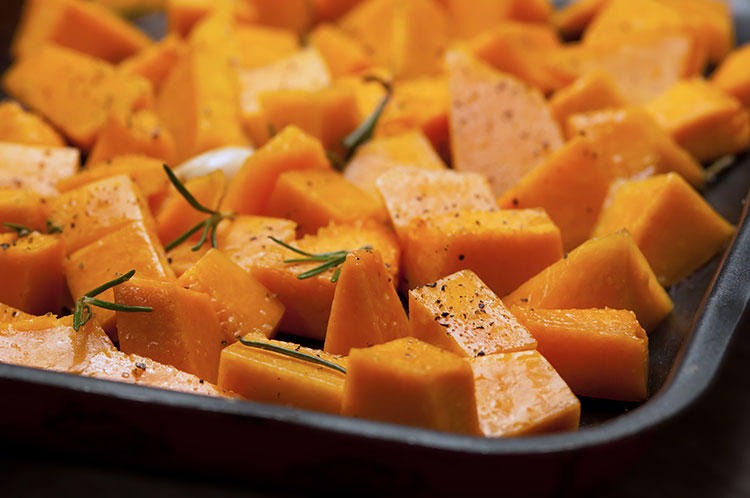Pumpkin, the star ingredient of the season
Pumpkin is one of the star ingredients of the autumn season. Discover the properties and benefits of different types of pumpkin. Let's cook!
fresh food
Share
Autumn is the season par excellence for the pumpkin, one of the season’s vegetables with great nutritional quality and, given its properties, we cannot fail to take advantage of it during this season. So that you don't waste this food, we’ll tell you all about the pumpkin: its properties, benefits and how to use it in the kitchen.
Different types of pumpkins
- WINTER OR GIANT PUMPKIN
This is one of the best-known pumpkin species. They're the big orange ones used for Halloween. It is a variety widely used for creams and pumpkin purees, but it is also delicious roasted in the oven because of the consistency of its pulp and its thin, soft skin.
2. BONETERA PUMPKIN
These can be cooked in various ways (fried, baked, stuffed...). Eating this one while it is still quite small is recommended because it is more tender. It is also used a lot for decoration, due to its particular shape and colours.
3. SPAGHETTI PUMPKIN
This is a creeping, winter variety, with cylindrical, yellow or orange fruits. It is a very special pumpkin, when cooked or baked its pulp breaks into strands that look like spaghetti. It is delicious with cheese and herbs and also with salt, pepper and butter.
4. TURBAN GOURDS
This is a variety that can be grown in summer and in winter. It has a very peculiar shape, and that is why it is frequently used as a decorative element. For making creams and purees it is also delicious and tasty, although it has a small amount of pulp and has many empty spaces inside.

5. PEANUT PUMPKIN
This is a large, elongated, pear-shaped pumpkin with an intense orange colour. Due to its sweet and creamy pulp, it is ideal for preparing creams and sweets. If unopened, it can be stored in perfect condition for months.
6. ANGEL HAIR PUMPKIN
There are several of these, but the most common pumpkin to make this sweet so commonly used in baking is the Cucurbita ficifolia. It has many common names: "alcayota", "cidra", "calabaza confitera", "cayote"... Visually it may remind you of a watermelon because of its almost perfect circumference and its green and yellowish colours forming striated shapes. Inside, the pulp is very light-coloured, practically white, with small black pips or seeds that are also reminiscent of those of the watermelon.
Benefits of eating pumpkin
- It helps us to stay slim. It is a food that contains very few calories, due to its high water content. In addition, it also has a large amount of fibre that will help us feel full, as well as accelerate and improve the digestive process. If we prepare the pumpkin as a cream or purée, this food will make us feel fuller sooner if we consume it hot, and thereby we consume less food.
- Protects the eyes. It is rich in antioxidants such as vitamin C, vitamin E and beta-carotene, which have proven to be excellent for eye health and preventing degenerative damage.
- Strengthens the immune system. The beta-carotenes present in this vegetable, which the body transforms into vitamin A, are very beneficial in helping us strengthen the cellular immune system, as it is a powerful natural antioxidant. The crushed pips are very good for eliminating and killing intestinal parasites.
- It regulates intestinal transit and prevents constipation. Pumpkin contains an appreciable amount of both soluble and insoluble fibre that aids intestinal transit.

Pumpkin storage
In order to choose a good pumpkin it is advisable to look at the skin. If this is smooth and fine, it might be a little unripe. The best ones are those with thick but intact skin, with the peduncle intact, and with a heavy weight in relation to its size. This way they will last several months, although it is always better to consume them when they are ripe.
The ideal place to keep them is a cool and dry place. Once opened, they will last a week in the refrigerator, when the skin is covered with film, or stored in a perforated bag.
Uses in the kitchen
Before using the pumpkin, it is advisable to clean it with a damp cloth. To cook it, there are several options:
•You can roast it in the oven cut in half and with the seeds removed, and then empty the pulp, mash it and use it in creams, soups or purees. Sliced and roasted in the oven with honey and spices, it offers a delicious dessert that is easy to prepare.
•It can be chopped and the skin, seeds and fibre removed, before steaming or boiling. The pumpkin should not be overcooked, a maximum of 20 minutes is enough; this preserves its flavour and nutrients.
Spices and aromatic plants complement it well in both sweet and savoury preparations: cinnamon, vanilla, star anise, cardamom, cumin, ginger, thyme, oregano, rosemary, fennel, cilantro, chives, basil, pepper... Curry also goes well with pumpkin, especially in soups.
Orange, whether the skin or the juice is used, gives it an acidic touch. And soy sauce is perfect for seasoning: cutting the pulp into large cubes and marinating it in a soy sauce dressing with aromatic herbs and garlic provides a starter or a garnish for meat or fish dishes.






